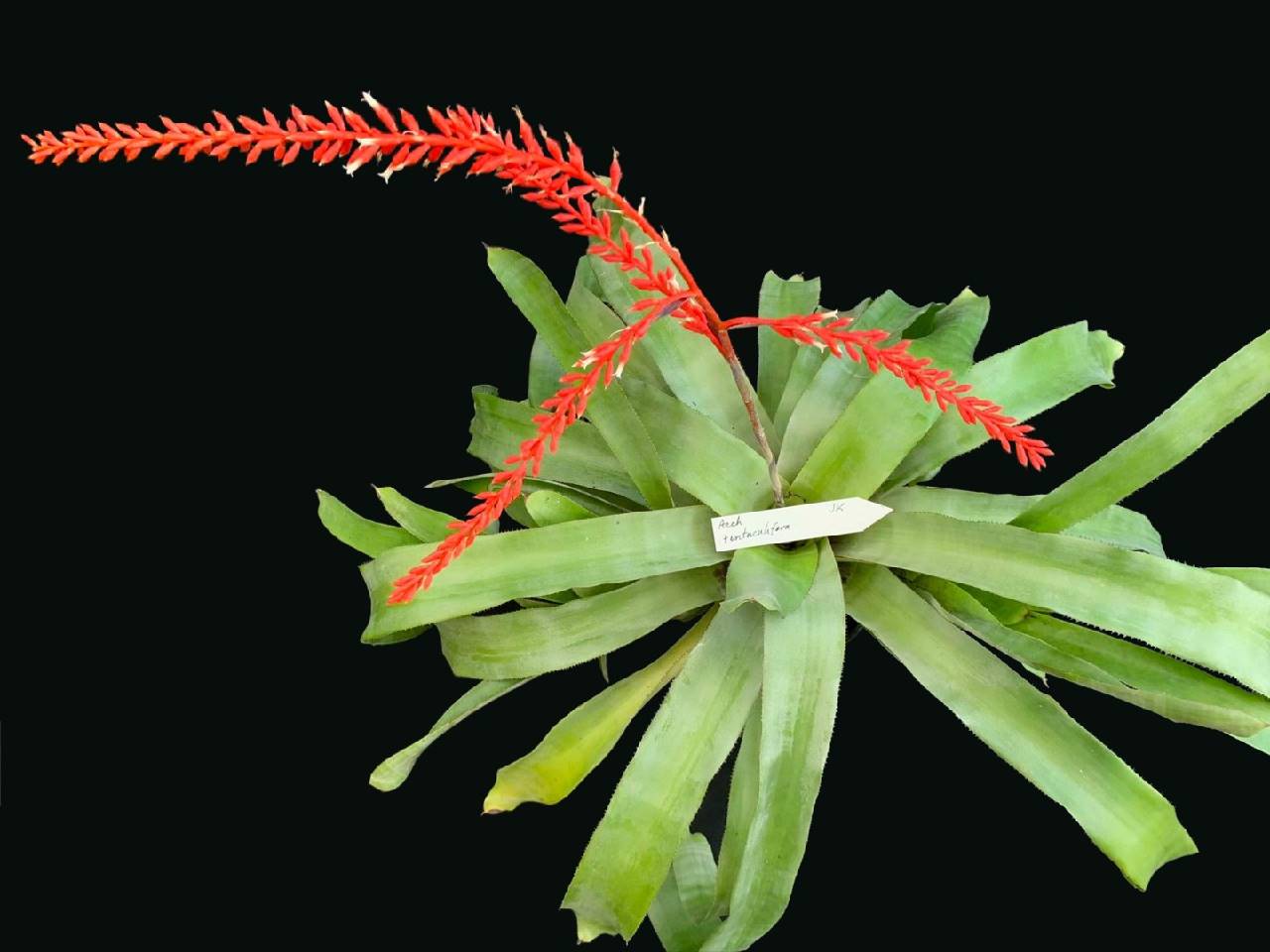
Habitats: Understory or canopy of humid montane forests.
Distribution area: Endemic to the Atlantic Forest of southeastern Bahia in Brazil at 700-1000 m a. s. l. Only known from two localities: Serra Bonita and Serra de Jacareci, near Camaca, and Santa Terezinha, respectively.
Additional specimens examined: Brazil: Monteiro 463 (RB).
Notes. This species is very distinctive within Wittmackia due to its long branches and bright red rachis, ovaries, and sepals.
Aechmea tentaculifera Leme, Amorim, & J A Siqueira sp. nov. Fragmentos de Mata Altantica do Nordeste: 391-2. 2006
Ab A froesii (L B Smith) Leme & J A Siqueira, cui affinis, laminis foliorumapice obtusis vel truncatus, ramis distincte longioribus, sepalis rubris apice mucrone ca. 2mm longo et ovario rubro et cylindraceo differt.
Type: Bahia, Camaca, RPPN Serra Bonita, 9.6 km north west of Camaca on the road from Jacareci to Jussari, 6km in the direction of Serra Bonita, 15º23’29”S 39º33’55”W, 820m elevation, 21st September 2004, WW Thomas, AM Amorim, JL Paixao & S Sant’Ana 14218 Holotype CEPEC, Isotype NY
Plant epiphytic 60-80cm high (with inflorescence extended), propagating by short offsets at the base.
Leaves 15-20, rosulate, sub-erect to arched, chartaceous to fine leathery, forming a funnel shaped rosette at the base,
Sheaths elliptic to oblong elliptic, 11-13 x 7-9mm, dense with minute white scales, dark purple on the abaxial face, colour partially obscured by the trichomes,
Blades linear, 20-27 x 5.4-8cm, green, sub-dense with inconspicuous whitescales on the abaxial face, inconspicuously white scaled to glabrescent on the adaxial face, inconspicuously narrowing toward the base, tip obtuse to truncate, distinctly apiculate, nearly black as well as the upper margins, densely spined, spines 1-2mm long, 1-4mm apart, narrow triangular, dark chestnut brown, straight or lightly retrorse,
Scape erect, slender, 26-28cm long, 0.3-0.5cm diam., sparsely white lanate to glabrescent, red, much shorter than the leaves,
Scape bracts narrow lanceolate, finely acuminate, 40-50 x 8-10mm, stramineous, purplish on the adaxial face, papyraceous to nerved, inconspicuously spined near the tip or entire, sparsely white lanate near the base to glabrescent, erect, shorter than or equalling the internodes,
Inflorescence paniculate, sparsely bipinnate, sub-erect, 30-50cm long, (with the terminal spike extended) Rhachis 3-5mm diam., sub-angular, slightly flexuous, sparsely white woolly glabrous, red.
Primary bracts similar to the upper scape bracts, gradually getting smaller in the direction of the top, entire, membranaceous, sub-erect to spreading, sparsely white lanate, exceeding the stipes.
Branches lateral ones numbering 1-4, spreading recurved, 17-29cm long, 2-2.5cm diam., with 43-60 flowers, stipes slender, ebracteate, 15-25 x 2mm, slightly complanate, red, Rhachis slender, straight or almost, 1-1.5mm diam., red, glabrous, slightly sulcate, terminal branch 30-40cm long, spreading recurved, with 80-100 flowers,
Floral bracts narrow triangular, acuminate caudate spinescent, red, nerved, entire, glabrous, slightly shorter than the ovary, ecarinate, 4-5 x 2mm,
Flowers sessile, 17-20mm long, not scented, sub-erect, sub-dense to densely disposed, almost uniformly distributed and slightly verticillate,
Sepals strongly asymmetric, with a membranaceous lateral wing, rounded and slightly exceeding the distal portion of the central nerve, nevertheless distinctly shorter than the apical mucron, ca 7.5 x 4mm including the apical mucron about 2mm long, connate at the base for about 0.5mm, red, ecarinate, glabrous.
Petals lanceolate to sub-spatulate, acuminate, 9-12 x 2-2.5mm, free, white, subspreading-recurved towards the tip at anthesis, with 2 appendages lacerate-digitate, 2.5-3 mm from the base, and with 2 callosities equalling the filaments;
Filaments plump, white, antisepalous ones free, 8-9mm long, antipetalous ones 7-8mm long, adnate to petals for ca 3mm;
Anthers ca 3mm long, dorsifixed ⅓ from the base, base obtuse, tip acuminate-caudate;
Pollen biporate, wide ellipsoid to subglobose, small pores, exina psillate, with longitudinal nerves;
Stigma conduplicate spiral, ellipsoid, lobes ca 1.5 mm long, green, subentire to short crenulate.
Ovary subcylindrical, 6-7mm long, 2-3mm diam., epigynous tube ca 1mm long, placenta apical, ovules apiculate
Fruit not known
Paratypes; BAHIA, Camaca, RPPN Serra Bonita, 9.6 km west of Camaca on the road to Jacareci, 6km south west of the road to RPPN Serra Bonita and Torre da Embratel, 835 m. elev. 29 Oct 2004, A M Amorim, J L Paixo, S Sant’Ana & L C J Gomes 4359 (CEPEC); Santa Terezinha, Pedra Branca, Nov. 1994, Edmundo Silva s n., fl. cult. Oct 2004, E Leme 5155 (HB); serra de Jacareci, F Azevedo s n. fl. cult. Sept 2005, L F N Cavalho 2751 (HB)
Discussion
Although the general aspect of this new species, especially the colour pattern, shows links to the Aechmea lingulata complex, A. tentaculifera has a motphological relationship with A. froesii. However, it differs in the leaf blades with obtuse to truncate tip (versus sharp to acuminate), branches distinctly longer than the assumed position of the tentacles (17-29cm vs. 5-12cm long, sepals vivid red (vs. green), with an apical mucron 2mm long, (vs. 1-1.2cm long), besides the red ovary (vs. green) and cylindric (vs. subclavate)
A. tentaculifera is endemic to the Mata Atlantica mountains of south Bahia, where it is known only from two localities. Living at altitudes about 700 – 1000m it grows as an epiphyte in sub-woodlands of primary and remnant Mata Atlantica forests bordering on Cocoa plantations.